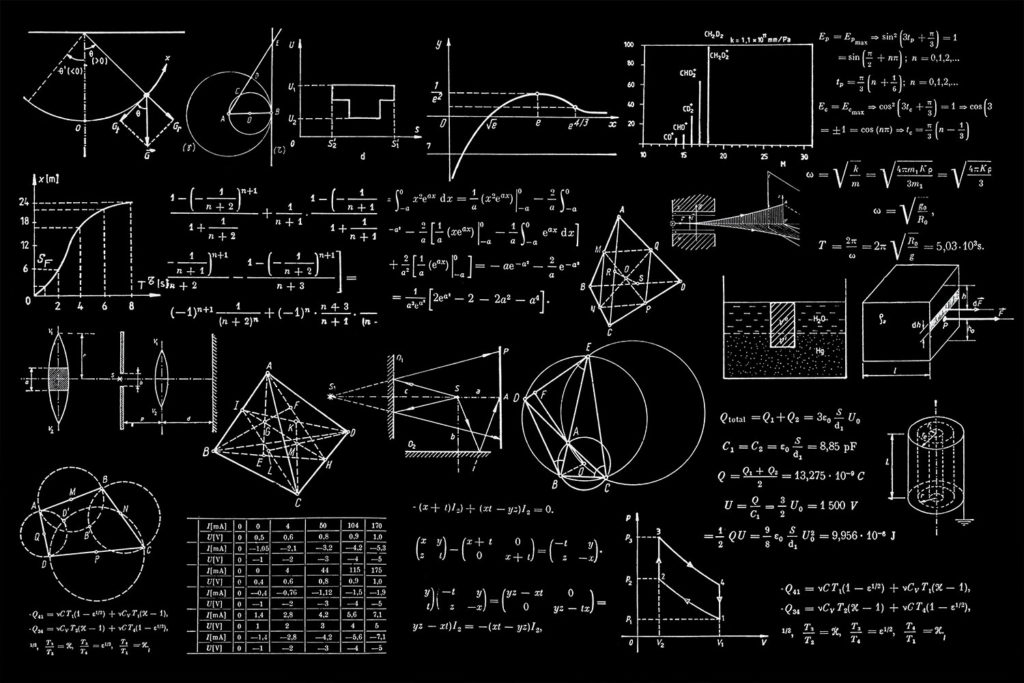By Bruce L Gordon, Ph.D.
History and Philosophy of Physics, Baylor University
Materialism (or physicalism or naturalism) is the view that the sum and substance of everything that exists is exhausted by physical objects and processes and whatever supervenes causally upon them. The resources available to the materialist for providing an explanation of how the universe works are therefore restricted to material objects, causes, events and processes. Because quantum theory is thought to provide the bedrock for our scientific understanding of physical reality, it is to this theory that the materialist inevitably appeals in support of his worldview. But having fled to science in search of a safe haven for his doctrines, the materialist instead finds that quantum theory in fact dissolves and defeats his materialist understanding of the world.
Before we launch into a more detailed defense of this claim, it will help for those who are unfamiliar with quantum theory to have at their disposal a few non-technical definitions of central concepts. First of all, what is quantum theory? Broadly speaking, it is the mathematical theory describing the behavior of the physical world at the smallest and most fundamental level. It is comprised of quantum mechanics and quantum field theory, along with a variety of associated concepts and applications.
-
Quantum mechanics describes the motion of objects at the atomic and subatomic scale. Fundamental to quantum mechanics is the duality of its phenomena – objects such as electrons and protons behave as either particles or waves depending on the experimental context. Similarly, radiation, such as light, exhibits both wave and particle behavior.
-
Quantum field theory is the quantum description of systems with an infinite number of degrees of freedom. It is frequently convenient to represent systems consisting of large numbers of objects – such as the ions and electrons in a metal or the nucleons in large nuclei – in the quantum field formalism.
-
Relativistic quantum field theory combines field theory (for example, the theory of the electromagnetic field), quantum mechanics and special relativity theory into a single mathematical structure. It is one of the primary tools of mathematical physicists. The search continues for an adequate quantum theory of gravity that would successfully express general relativity as a quantum field theory.
-
Quantum cosmology applies the quantum theory of fields to the question of the origin of the universe and its early development, but an adequate quantum cosmology ultimately requires a complete theory of quantum gravity.
-
One of the chief characteristics of quantum phenomena is their nonlocality and nonlocalizability. Every time a quantum object or system interacts with another quantum object or system, their existence becomes “entangled” in such a way that what happens to one of them instantaneously affects the other no matter how far apart they have separated. Since local effects obey the constraints of special relativity and propagate at speeds less than or equal to that of light, such instantaneous correlations are called nonlocal, and the quantum systems manifesting them are said to exhibit nonlocality. A result in mathematical physics called Bell’s theorem – after the Irish physicist who proved it – shows that no hidden (empirically undetectable) variables can be added to the description of quantum systems exhibiting nonlocal behavior which would explain these instantaneous correlations on the basis of local considerations.
When such local variables are introduced, the predictions of the modified theory differ from those of quantum mechanics. A series of experiments beginning with those conducted by Alain Aspect at the University of Paris in the 1980s has demonstrated quite conclusively that quantum theory, not some theory modified by local hidden parameters, generates the correct predictions. The physical world, therefore, is fundamentally nonlocal and permeated with instantaneous connections and correlations. Nonlocalizability is a related phenomenon in relativistic quantum mechanics and quantum field theory in which it is impossible to isolate an unobserved quantum object, such as an electron, in a bounded region of space. As we shall see, nonlocality and nonlocalizability present intractable problems for the materialist.
The ground has now been laid to summarize an argument showing not only that quantum theory does not support materialism but also that it is incompatible with materialism. The argument can be formulated in terms of the following premises and conclusion:
- P1. Materialism is the view that the sum and substance of everything that exists is exhausted by physical objects and processes and whatever supervenes causally upon them.
- P2. The explanatory resources of materialism are therefore restricted to material objects, causes, events and processes.
- P3. Neither nonlocal quantum correlations nor (in light of nonlocalizability) the identity of the fundamental constituents of material reality can be explained or characterized if the explanatory constraints of materialism are preserved.
- P4. These quantum phenomena require an explanation.
_____________________________________________ - C Therefore, materialism/naturalism/physicalism is irremediably deficient as a worldview, and consequently should be rejected as false and inadequate.
The first two premises of this argument are uncontroversial: the first is just a definition and the second is a consequence of this definition. The key premises of the argument are thus the third and fourth; once these are established, the conclusion follows directly. Let’s focus our attention, therefore, on justifying the claims in premises three and four.
In order for a particle to be a material individual, it must possess one or more well-defined and uniquely identifying properties. The prime example of such a property is spatio-temporal location. In order for something to exist as an individual material object, it must occupy a certain volume of space at a certain time. If it does not, then whatever it is – if it’s anything at all – it’s not a material object. The problem for the materialist is that the particles of relativistic quantum mechanics are not so localizable.
Stated roughly, Gerhard Hegerfeldt and David Malament have shown that if one assumes (quite reasonably) that an individual particle can neither serve as an infinite source of energy nor be in two places at once, then that particle has zero probability of being found in any bounded spatial region, no matter how large! In short, the “particle” doesn’t exist anywhere in space, and so, to be honest, it doesn’t really exist at all. Hans Halvorson and Robert Clifton have extended these results and closed some loopholes by showing that the Hegerfeldt-Malament proof still works under conditions that are even more general. In particular, they’ve shown that once relativity is taken into account, there can be no intelligible notion of microscopic material objects. Particle talk has pragmatic utility in relation to macroscopic appearances, but it has no basis in microphysical reality (and this is the rock-bottom reality for the materialist).
The underlying problem is this: there are correlations in nature that require a causal explanation but for which no physical explanation is in principle possible. Furthermore, the nonlocalizability of field quanta entails that these entities, whatever they are, fail the criterion of material individuality. So, paradoxically and ironically, the most fundamental constituents and relations of the material world cannot, in principle, be understood in terms of material substances. Since there must be some explanation for these things, the correct explanation will have to be one which is non-physical – and this is plainly incompatible with any and all varieties of materialism.
One possible materialist strategy of defense is to claim that nonlocal phenomena do not require an explanation since, while they may be a bit puzzling epistemically, they are not, ultimately, metaphysically problematic. This idea that none of the regularities in nature need causal grounding is captured in a concept that David Lewis calls “Humean supervenience.” Humean supervenience is intended as an account of how nature determines what is true about laws and chances quite independently of what we humans believe about the world – in other words, it is still to be understood as an ontological theory, not an epistemic one. The theory takes the fundamental relations of the world to be spatio-temporal in a manner consistent with special relativity, and has an ontology of points – or point-sized occupants of points – along with local qualities that are their intrinsic properties. Everything else supervenes on this spatio-temporal arrangement of local qualities. On this view, observed natural regularities are laws just in case they are the theorems of an axiomatic deductive system whose theorems are true and which strikes an optimal balance between simplicity and informativeness. Lewis postulates that there is exactly one best such system.
But this borders on incoherence. Humean supervenience would require that quantum outcomes, while nonlocally correlated, should nonetheless be understood in terms of local properties. Under such conditions, it becomes necessary to postulate random devices in harmony at spacelike separation without any deeper ontological explanation. Perhaps I can engender the requisite sense of puzzlement in the following way: accepting the plausibility of Humean supervenience in this context would be equivalent to believing that people sitting at typewriters in rooms on opposite sides of the world and simultaneously producing identical texts were not and had never been in communication with each other. The quantum description of the world is at least this improbable under Humean supervenience, with the added wrinkle that no common cause in the history of the system or locally transmitted information can account for the correlation. Incredulity is not just the natural response here, it is a necessary response. When the implications of the concept are grasped, Humean supervenience serves as a reductio of itself. So I repeat: a deeper explanation for quantum nonlocality is required and no physical explanation is possible.
The challenge to making metaphysical sense of quantum theory, therefore, is to give an account of what the world is like when it has an objective structure that does not supervene on material objects. With this stricture, the rather startling answer that begins to seem plausible is that preserving and explaining the objective structure of appearances requires reviving a type of phenomenalism in which our perception of the physical universe is constituted by sense-data conforming to certain structural constraints, but absent a material reality giving rise to these sensory perceptions. What remains, therefore, is an ontology of minds experiencing and generating mental events and processes that, when sensory in character, have a formal structure characterized by the fundamental symmetries and constraints represented in physical theory. The fact that these sensory perceptions are not mostly of our own making points to the falsity of any solipsistic inclination, but it also engenders some metaphysical and epistemological puzzlement. There is, however, one quite reasonable way to ground this ontology and obviate puzzlement: metaphysical objectivity and epistemic intersubjectivity are preserved in a theistic metaphysics that looks a lot like the immaterialism proposed by George Berkeley and Jonathan Edwards.
Bruce Gordon received his Ph.D. in the history of philosophy of physics from Northwestern University. His primary research interests are in the areas of philosophy of science, philosophy of physics, analytic metaphysics, philosophical theology, and questions at the intersection of these disciplines. He has been at Baylor University since 1999 in the role of an administrator and adjunct assistant professor of philosophy. He is currently a scholar in residence at the Baylor Institute for Faith and Learning.
Published March 30, 2016




